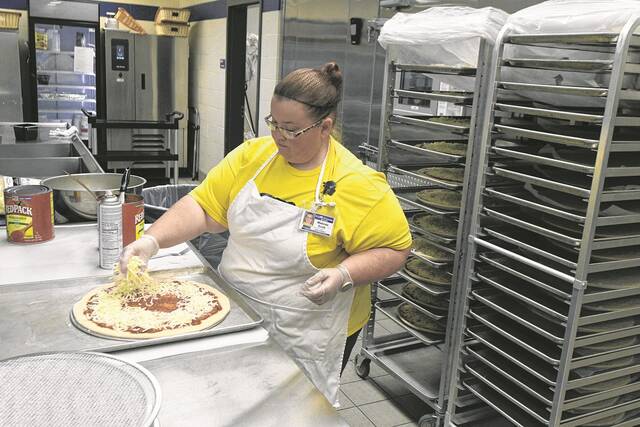National supply and worker shortages means longer hours for a local school’s cafeteria manager.
Melinda Scott gets to work at 5:15 a.m., long before Franklin Community Middle School students arrive, to start the three-hour process of preparing dough for hundreds of lunchtime pizzas.
Scott used to get to work at 6 a.m., back before the school’s food service workers made the pizzas themselves. Instead, nationwide supply chain issues have delayed shipments of everything from cars to technology to food. The supply chain issues are a result of recovery from the pandemic, as consumers who saved money when businesses shut down early on during the COVID-19 crisis now have extra money to order items, exhausting inventories, according to federal officials.
The supply chain issues are further exacerbated by a workforce shortage that has impacted everything from the warehouses where items are prepared and packaged, to the trucking companies that deliver them. There was an all-time record of 8.3 million job openings in April across the country, federal officials said.
At local schools, those supply chain issues translate to certain food options being unavailable. It’s one reason Franklin Community Middle School staff now make pizzas from scratch and have to find substitutes for popular chicken items, said Elizabeth Edwards, food service director.
“We’re having a terrible time getting most types of chicken,” Edwards said. “Shipments will come in, and if we don’t act fast, people will order them. Chicken and pizzas are hardly available right now, and then there’s breakfast items. It’s really difficult to source for breakfast, like cereal, pancakes, waffles and French toast.”
Instead of chicken sandwiches, students eat pulled barbeque sandwiches. Instead of pancakes and waffles, they eat breakfast bars and omelets, she said.
Food service staff at Indian Creek schools have also had problems getting pizza and certain types of chicken, said Carol Schaff, the district’s food service director.
“We can usually find something to replace it. It could be breadsticks (instead of pizza). With chicken, instead of a patty, it might be tenders or nuggets. Right now, we can get chicken, but it might not be what’s on the menu,” Schaff said.
“It all has to do with the supply chain and lack of drivers. Different food comes from different manufacturers. Some manufacturers are having more trouble than others, but it’s across the board when it comes to chicken. There are fewer people that work in factories that produce the items. Some of the items that we had bid are no longer available, and manufacturers have cut some items that weren’t selling as well as others. We just heard that there was a cheese-stuffed pretzel we were ordering and they discontinued that.”
The shortages put stress on the entire food service staff, especially managers who have to deal with vendors, she said.
Finding acceptable food substitutes is difficult due to the need to meet certain nutritional thresholds, said Craig Niehaus, food service director at Clark-Pleasant schools.
“On the menu, for example, we might have one flavor of pancake, triple berry French toast, and might have to use chocolate or a different brand as a replacement that might not have the nutritional characteristics of the original product,” Niehaus said.
“We have to meet nutritional values. When we ran out of a product, I would look for a replacement and realize how niche an item was being low in sodium.”
But sometimes, the need to substitute items causes cafeteria staff to accidentally discover new favorites. Instead of Bosco sticks, which are bread sticks filled with cheese, for example, food service staff at Clark-Pleasant schools served mozzarella sticks, Niehaus said.
“With mozzarella sticks, the first day at the high school, we went through 900 servings or something extremely high. It was shocking,” Niehaus said. “Some of the new breakfast items we switched to are also popular. We have a cheese Danish that tastes like cinnamon toast crunch. They are used in place of cinnamon rolls.”





